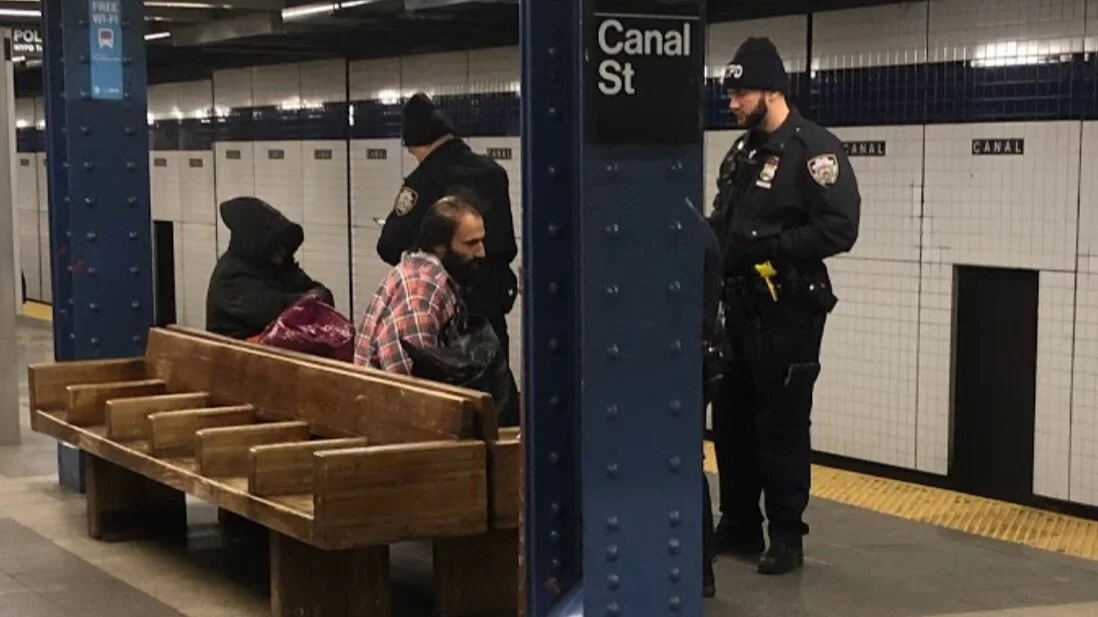Here’s How the Program Works:
Click the links above, or scroll down, for details and videos
Step 1: NYPD Targets Homeless Person
“The homeless are now clearly being targeted as violators of transit rules and being treated differently than any other citizen. Using the technicality of not having identification or an address, the NYPD is using this as an excuse to have a legal interaction with homeless individuals. This is a drastic change compared to how we have treated the homeless in the past.”
— Anonymous NYPD Transit Officers
Watch as NYPD Transit Officers hold up the trains to scan them for homeless people:
An officer scans a train for homeless people, and tells the conductor to wait as he finishes looking.
Step 2: NYPD Removes Person from Train
“The most common violation, called outstretched, is the same violation committed by anyone who even lays their bag on another seat. This is something we all have done ourselves and witness everyday. Those situations are not addressed in the same manner. Can you imagine if we arrested someone in a business suit, on their commute home, with their briefcase on the seat next to them and happened to have forgotten their ID that day?”
— Anonymous NYPD Transit Officers
Video 1: Watch as an NYPD Transit Officers brings a woman off the train. Her crime: Taking up more than one seat.
An officers pulls a homeless woman off the train for being “outstretched,” taking up more than one seat.
Video 2: A man is handcuffed and brought into the Transit District from the subway platform. The officer explains the protocol.
An officer explains that he is handcuffing a homeless person and giving him a summons.
Step 3: NYPD Gives Person a Summons
“NYPD brass are using the Diversion Program as a new quota, implemented through the use of the usual fear-driven tactics to motivate its Officers to complete the task. We are constantly being threatened and told by our immediate supervisors to get diversions. We are being boldly told how many to bring in a day. In addition, we now have forced overtime, disguised as quality of life operations. They are being team led by a supervisor to make sure we are arresting the homeless, rather than offering them services in the field.”
— Anonymous NYPD Transit Officers
Below, you can see two people removed from trains within minutes of each other. They are seated next to one another as officers give them summonses.
Note: In some cases, the summons is not given until the person is brought up to the Transit Command.
Step 4: NYPD Brings Person to Transit District
“What the public isn't being told is that homeless people are now being handcuffed, put over the radio as an arrest, and then brought into our transit commands. There, the homeless individuals are being coerced into services that could have been provided without having to handcuff and bring them in. They are being threatened to accept services and told that if they refuse, they will get a ticket, which most can't afford to pay, or go to jail for a violation that the Manhattan DA has already made clear will be refused for prosecution anyway. It isn't about helping them.”
— Anonymous NYPD Transit Officers
Below are two videos of men being brought up from the platforms where they were pulled off the trains.
A homeless man is brought up to the Transit Command as part of the “Diversion Program” with two officers, one of whom is in plain clothes.
A man is brought up from the station to the command, despite clearly not wanting to go.
Step 5: Person Leaves with Summons or Meets BRC
“Option” 1: Leave With Summons
If someone wants to leave without meeting an outreach worker, they are free to do so, but they leave with their summons. Some people choose this option because they know that BRC will not be able to provide them with the resources they want and need (a safe haven or permanent housing). Others choose this option just so they can escape the traumatic situation sooner.
“Option” 2: Meet with BRC
Some people will choose to meet with BRC. Because BRC has been providing outreach services on the subways long before the Subway Diversion Program, it is very likely that the person has worked with BRC before. The meeting with BRC will likely be brief: They will be offered a shelter (which they know about and avoid for legitimate reasons), but it’s unlikely that they will be offered what they want and need (a safe haven or permanent housing). After hearing the offer, they are free to leave with their summons allegedly vacated.
Watch NYPD try to coerce this man into meeting with BRC (“Option” 2), and watch how they respond when he says, “I don’t want to go.”
A man was being coerced into meeting with an outreach team, and is ultimately arrested for refusing to go.
How It Doesn't Work:
In this clip, the Mayor says, “If you’re in the subway and you’re homeless, you did something wrong, you could go through the criminal justice system. Or instead, you could go to a safe haven. Right away. Here’s a choice.”
The Mayor’s statement is incredibly misleading: It would be very unlikely that someone would be offered a safe haven right away. The safe haven system is at capacity, there is a long wait-list, and there is a bureaucratic process to prove eligibility.
In reality, they would most likely be offered a shelter, which they already know about and avoid for rational and legitimate reasons.
The Mayor should end the Subway Diversion Program and refocus his energy on building safe havens and permanent housing, so people do not need to sleep on the trains.

